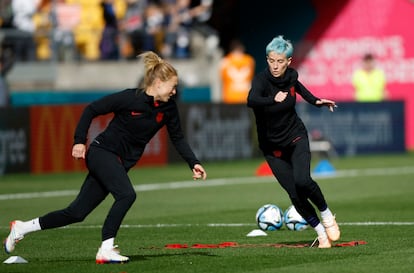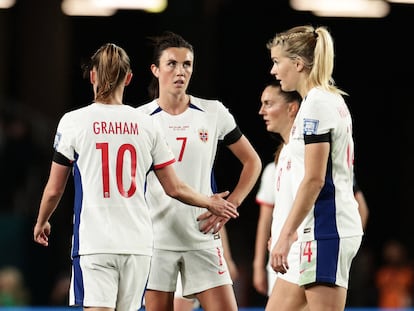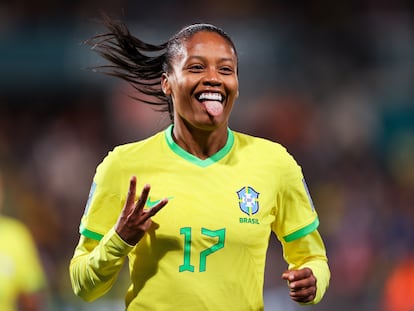LGBTQ+ community proud and visible at Women’s World Cup
The website Outsports, which covers the gay sports community, says there’s at least 95 out LGBTQ+ athletes competing in the soccer tournament

New Zealand striker Hannah Wilkinson has helped create two milestones at the Women’s World Cup. With her 48th-minute goal in the tournament opener against Norway, she led the co-host Football Ferns to their first win in six trips to the Women’s World Cup. She’s also one of at least 95 out members of the LGBTQ+ community competing in this year’s tournament, according to a count being kept by Outsports, a website that covers the LGBTQ+ sports.
The Ferns were greeted with a fan-made sign at their next match in Wellington: “Gay for soccer, gay for Wilkie,” it read.
The 95 out participants make up roughly 13% of the 736 total players at the Women’s World Cup, more than doubling the 40 players and coaches Outsports counted in 2019. The 2023 tournament also is hosting the first openly trans and non-binary player in either a men’s or Women’s World Cup, Quinn of Canada.
“Last World Cup was so big, especially with the visibility of the U.S. women’s national team winning and (Megan Rapinoe) fighting with (Donald) Trump. So I think that was a huge year for LGBTQ+ visibility,” said Lindsey Freeman, a professor of sociology and anthropology at Simon Fraser University in British Columbia.
“It’s just the ad hoc, fun culture of women’s soccer that you’re seeing in this World Cup,” said Freeman, who is in New Zealand conducting research on the topic.
Jim Buzinski, co-founder of Outsports, agreed. “In the Western world, it’s such a non-issue that it really just doesn’t get talked about,” he said. “And I think that’s in a good way.”
Visibility
Prior to the start of the tournament, FIFA designated eight socially conscious armbands team captains could wear throughout the Women’s World Cup. The decision came after “One Love” armbands were denied to men’s teams in Qatar in 2022.
The armbands being used this year include anti-discriminatory sayings and multiple colors, but the rainbow version Germany wanted to use is not allowed. None of the available options explicitly mention LGBTQ+ rights.
The decision has led many players to express their support in more creative ways across Australia and New Zealand.
New Zealand midfielder Ali Riley was interviewed on the official Women’s World Cup broadcast after her team’s upset of Norway. Her painted fingernails, left hand in the colors of the pride flag and right hand as the trans flag, were clearly visible as she held her head and fought back tears.
“She’s such an advocate and she’s definitely someone who uses her platform in such a positive way. We are all so proud of her and the way she represents the LGBTQ+ community,” teammate CJ Bott said. “Good on her. We’re all backing her, and we all back the community as well.”
The Philippines, making its Women’s World Cup debut, took home its own historic win over New Zealand 1-0 thanks to the foot of Sarina Bolden. Bolden’s Instagram bio reads, “i just wanna have fun n b gay.”
Irish star Katie McCabe wowed fans with a goal directly from a corner kick. She’s also made tabloid news for her relationships with other players.
Thembi Kgatlana, who has scored in the tournament for South Africa, has a patch of her hair dyed rainbow colors.
“My personality is very big for me, and my hair has become a part of my personality,” Kgatlana said. “And I did this rainbow because I want to represent all the people that are part of the LGBTQ and cannot talk while in countries where they’re oppressed.”
Fan experience
Kristen Pariseau and her wife started a U.S. women’s national team supporters group on Facebook ahead of traveling to this year’s Women’s World Cup. Aside from some hateful users she blocked, it’s been “super LGBT friendly.”
She and her wife did not go to Qatar for the 2022 men’s World Cup to avoid referencing each other as friends and receiving questions on their sexuality. In New Zealand, she said she’s met many same-sex couples at games and while traveling around the country.
“Everywhere you turn, it’s like, ‘Oh, my wife, my girlfriend.’ It’s been so welcoming and open,” Pariseau said. “In a way, it is kind of cool to be where there’s a lot of other people like you.”
Kelsie Bozart took her own pride flag armband to the United States’ second match in Wellington, along with a pride scarf.
“If you look back a couple years, I feel like it just wasn’t really talked about or there just wasn’t much of a presence,” Bozart said. “But moving forward, I feel like, especially for the U.S., they’ve done an amazing job of just incorporating pride and LGBTQ.”
Not universal
Though this year’s tournament has highlighted vast gains for the LGBTQ+ community in women’s soccer, advocates feel there is still work to be done.
According to Buzinski and Outsports, there were at least 186 LGBTQ+ athletes at the Tokyo Olympics. Women outnumbered men by a 9:1 ratio. There also were no confirmed out players at the 2022 men’s World Cup.
“I think women’s sports have always been open,” Denmark striker Pernille Harder said, adding that there are many role models for women who want to come out.
Freeman said it would be good to see men feel the same level of comfort.
“What can happen in the women’s game, I would love to spill over to the men’s game,” she said. “Because obviously, there’s way more queer players in the men’s game and it’s just not safe for them to come out.
“If you want to say that you’re in an inclusive space, you really have to be an inclusive space,” Freeman added. “And I think that that includes also holding the World Cup in places where it’s fine to be a queer person.”
Sign up for our weekly newsletter to get more English-language news coverage from EL PAÍS USA Edition
Tu suscripción se está usando en otro dispositivo
¿Quieres añadir otro usuario a tu suscripción?
Si continúas leyendo en este dispositivo, no se podrá leer en el otro.
FlechaTu suscripción se está usando en otro dispositivo y solo puedes acceder a EL PAÍS desde un dispositivo a la vez.
Si quieres compartir tu cuenta, cambia tu suscripción a la modalidad Premium, así podrás añadir otro usuario. Cada uno accederá con su propia cuenta de email, lo que os permitirá personalizar vuestra experiencia en EL PAÍS.
¿Tienes una suscripción de empresa? Accede aquí para contratar más cuentas.
En el caso de no saber quién está usando tu cuenta, te recomendamos cambiar tu contraseña aquí.
Si decides continuar compartiendo tu cuenta, este mensaje se mostrará en tu dispositivo y en el de la otra persona que está usando tu cuenta de forma indefinida, afectando a tu experiencia de lectura. Puedes consultar aquí los términos y condiciones de la suscripción digital.
More information
Últimas noticias
Most viewed
- David King, chemist: ‘There are scientists studying how to cool the planet; nobody should stop these experiments from happening’
- Mexico completes its trade shift with the entry into force of tariffs on China and countries without trade agreements
- Reinhard Genzel, Nobel laureate in physics: ‘One-minute videos will never give you the truth’
- Oona Chaplin: ‘I told James Cameron that I was living in a treehouse and starting a permaculture project with a friend’
- Sinaloa Cartel war is taking its toll on Los Chapitos










































